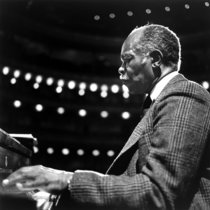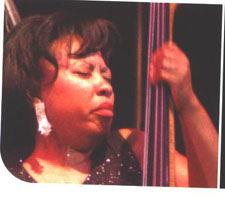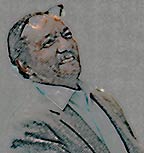We attended Al’s funeral yesterday at Forest Lawn’s Church of the Hills, followed by a gathering at the Hollywood Roosevelt Hotel. Bass players in attendance included Richard Davis (he flew in from Wisconsin) Jimmy Bond, Jennifer Leitham, Richard Simon (who along with pianist Phil Wright, accompanied Ernie Andrews in his rendition of “My Way” with lyrics by Howlett Smith) and Howard Rumsey. Of course there were many other musicians on the scene — Kenny Burrell, Herman Riley, Charles Owens, Clora Bryant, Donald Vega, Michael Melvoin, and Jake Hanna, to name a few — but what touched me most were the tributes and reminiscences shared by other people whose lives he touched: his next door neighbor, his dentist, a fan, and his hanging and dining buddy Gary Chen-Stein.
Neither John nor I spoke at the service, but here’s what I would have said:
Big Al looked tough and mean – that is, until he smiled. He was also an exceptional listener and a loyal friend who refrained from judging people…unless they did him wrong. He mastered the art of overt generosity while still wringing blood from a nickel. He could grumble a lot, but he never gave up. He was 80 years old when his first recording as a leader was released. Tumbao Para Los Congueros Di Mi Vida was followed five years later by Black Orchid, and both albums are deeply steeped in Afro-Cuban flavors. If anything could surpass the joy he felt in creating those recordings, it was his trip to Cuba last November. There he found a beautiful country with smiling faces, warm sun and great music – everything the world should be. Despite its poverty, Cuba was his heaven.
Al was a proud man who maintained the best of “old-fashioned†values: he was a man of his word (and you’d best stick to yours, too), he liked to shop for clothes and dress well, he preferred for everything and everyone to run on time, (including his wives and daughters), and he was fiercely independent. Al always spoke his mind, regardless of the consequences, and yes, it got him fired plenty of times. But when it came to darker feelings, he was very private and hid any despair. He was extremely intelligent and well-read, but when asked what college he attended, he’d say “the one behind the Bass looking out at the world.” He loved to travel and meet people from all over the world. Whenever language was a barrier, music was always the solution.
Al was a big man with big heart and we will miss him.


 On Sunday, July 31st, pianist Hank Jones will celebrate his 87th birthday, just shy of one year for each key on the piano. Hank was born in Vicksburg, MS on July, 31, 1918, and NPR’s Jazz Profiles, hosted by Nancy Wilson, is celebrating. Check the
On Sunday, July 31st, pianist Hank Jones will celebrate his 87th birthday, just shy of one year for each key on the piano. Hank was born in Vicksburg, MS on July, 31, 1918, and NPR’s Jazz Profiles, hosted by Nancy Wilson, is celebrating. Check the  July 31st is also guitarist Kenny Burrell’s birthday — born in Detroit, MI in 1931, he will be 74. A prolific recording artist and composer, Kenny is also the Director of the Jazz Studies Program at UCLA Department of Ethnomusicology His UCLA faculty bio is
July 31st is also guitarist Kenny Burrell’s birthday — born in Detroit, MI in 1931, he will be 74. A prolific recording artist and composer, Kenny is also the Director of the Jazz Studies Program at UCLA Department of Ethnomusicology His UCLA faculty bio is  Luther Henderson was a composer, arranger, conductor, musical director, orchestrator, and pianist. He was a proud black man who graduated from the Julliard School of Music in 1942, and in 1956, married a white woman, his second wife. He was Duke Ellington’s “classical arm,†orchestrating music for Beggar’s Holiday, Three Black Kings, and other symphonic works. Duke spoke highly of Luther, but seldom gave him the credit he was due. Luther was Lena Horne’s pianist and musical director. During his sixty-year career in music, he worked his magic on some of Broadway’s greatest musical hits, including Flower Drum Song, Funny Girl, No No Nanette, Purlie, Ain’t Misbehavin’, and Jelly’s Last Jam, starring such performers as Barbra Streisand, Laine Kazan, Robert Guillaume, Savion Glover, Andre Deshields, Tonya Pinkins, and Gregory Hines. His music was heard on television programs such as The Ed Sullivan Show, The Bell Telephone Hour, and specials for the pop stars of the day including Dean Martin, Carol Burnett, Andy Williams, Victor Borge, and Polly Bergen.
Luther Henderson was a composer, arranger, conductor, musical director, orchestrator, and pianist. He was a proud black man who graduated from the Julliard School of Music in 1942, and in 1956, married a white woman, his second wife. He was Duke Ellington’s “classical arm,†orchestrating music for Beggar’s Holiday, Three Black Kings, and other symphonic works. Duke spoke highly of Luther, but seldom gave him the credit he was due. Luther was Lena Horne’s pianist and musical director. During his sixty-year career in music, he worked his magic on some of Broadway’s greatest musical hits, including Flower Drum Song, Funny Girl, No No Nanette, Purlie, Ain’t Misbehavin’, and Jelly’s Last Jam, starring such performers as Barbra Streisand, Laine Kazan, Robert Guillaume, Savion Glover, Andre Deshields, Tonya Pinkins, and Gregory Hines. His music was heard on television programs such as The Ed Sullivan Show, The Bell Telephone Hour, and specials for the pop stars of the day including Dean Martin, Carol Burnett, Andy Williams, Victor Borge, and Polly Bergen.  Have you ever heard of Nedra Wheeler? I can’t believe that I have not been aware of her until now, especially when I read her credits that include live and recorded performances with Ella Fitzgerald, Billy Higgins, Harper Brothers, Cedar Walton, Branford Marsalis, Billy Childs, and Stevie Wonder, to name just a few.
Have you ever heard of Nedra Wheeler? I can’t believe that I have not been aware of her until now, especially when I read her credits that include live and recorded performances with Ella Fitzgerald, Billy Higgins, Harper Brothers, Cedar Walton, Branford Marsalis, Billy Childs, and Stevie Wonder, to name just a few.